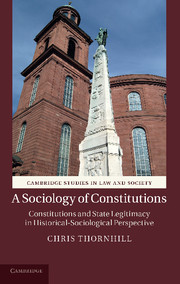 A Sociology of Constitutions
A Sociology of Constitutions Book contents
- Frontmatter
- Contents
- Acknowledgements
- A note on texts and translations
- Introduction
- 1 Medieval constitutions
- 2 Constitutions and early modernity
- 3 States, rights and the revolutionary form of power
- 4 Constitutions from empire to fascism
- 5 Constitutions and democratic transitions
- Conclusion
- Bibliography
- Index
5 - Constitutions and democratic transitions
Published online by Cambridge University Press: 07 September 2011
- Frontmatter
- Contents
- Acknowledgements
- A note on texts and translations
- Introduction
- 1 Medieval constitutions
- 2 Constitutions and early modernity
- 3 States, rights and the revolutionary form of power
- 4 Constitutions from empire to fascism
- 5 Constitutions and democratic transitions
- Conclusion
- Bibliography
- Index
Summary
The first wave of transition: constitutional re-foundation after 1945
The period after 1945 witnessed a wave of constitution drafting in many of the states that either converted to fascism in the 1920s or 1930s or were subject to fascist occupation before or during the Second World War. In many instances this process of constitutional reform reflected the extension of Soviet influence across eastern and central Europe, and it was initiated by the government of the Soviet Union. Key examples of constitutions written at this time were the constitution of Hungary of 1949, the constitution of Czechoslovakia of 1948, the Polish constitution of 1952 and the Bulgarian constitution of 1947.
Constitutions reflecting the political dominance of the Soviet Union contained substantial distinctions, and each of them retained elements of indigenous legal culture. However, these constitutions derived some elements from the 1936 constitution of the Soviet Union, and they had important common features. First, they organized the state as a one-party regime committed to a high degree of economic control. Second, they rejected the separation of powers, which was commonly derided in post-1945 eastern Europe as characteristic of bourgeois constitutionalism: they provided for an integrally unified state structure, founded in the notional principle of full popular sovereignty or ‘unitary popular power’ (Skilling 1952: 208), in which both legislative and executive authority was concentrated in a unicameral legislature, dominated by a single (non-elected) party – this effectively tied legislative power to the prerogatives of a party executive.
- Type
- Chapter
- Information
- A Sociology of ConstitutionsConstitutions and State Legitimacy in Historical-Sociological Perspective, pp. 327 - 371Publisher: Cambridge University PressPrint publication year: 2011
